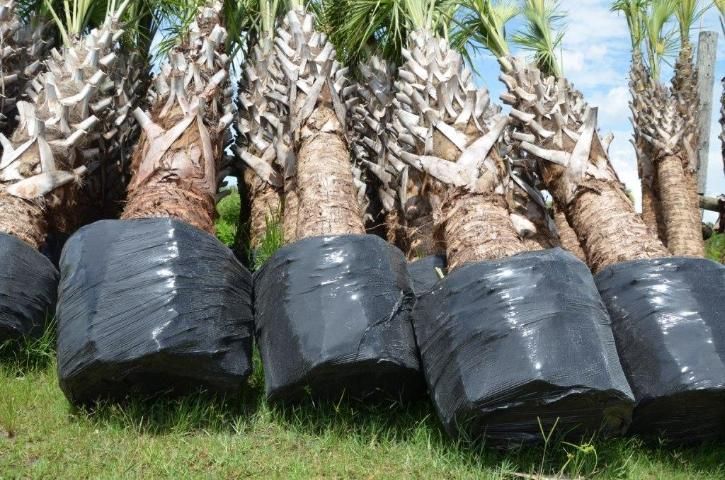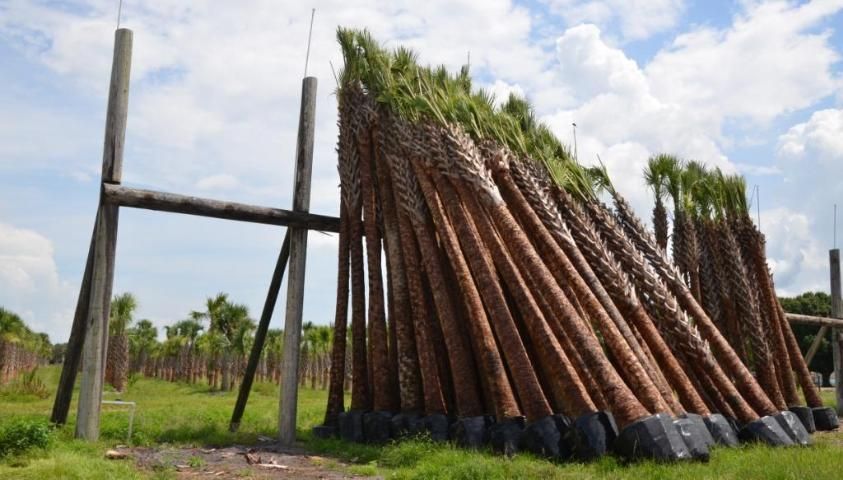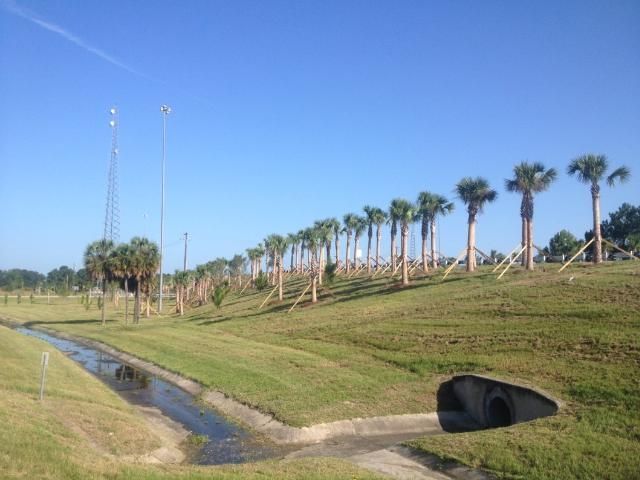Introduction
Palms are woody monocots characterized by the production of adventitious roots from the base of the trunk. Unlike the woody roots of dicots, such as oaks, gumbo limbo, and sea grapes, palm roots have no secondary thickening. Also, unlike trees, palms are incapable of repairing damage to their trunks. Most importantly, the life of a palm is dependent upon the continued good health of the single growing bud known as the meristem. Thus, if the palm bud is killed, the entire palm or the palm cane will eventually die.
Harvesting and Transplanting Sabal Palms
The sabal or cabbage palms (Sabal palmetto) seen throughout Florida landscapes are typically not grown in nurseries from seeds. Instead, they are commonly harvested or dug from native stands, fields, and pastures and installed in a variety of landscapes. Roots of harvested sabal palms do not survive the digging process and new roots must be initiated from the trunk. During the period of root regrowth, the palm survives by moving water stored in its trunk to help it produce new roots and leaves. Losses associated with transplanting are due in large part to the loss of functioning roots and insufficient water stored in the trunk.
Cropped Transplants
The traditional way of transplanting sabal palms is to crop them when harvested, which is the removal of all of the palms' leaves. This is done to eliminate leaf transpiration and conserve water to promote new root growth and palm establishment. Cropping is sometimes confused with "hurricane cutting." Hurricane cutting is a drastic, damaging pruning process mistakenly carried out to reduce wind loading in palms. Unlike hurricane cutting, there is research that indicates cropping is an effective means of reducing transplant loss. That said, regrowth from a completely cropped canopy to a full and rounded crown in the landscape can take as many as two years. For some landscape situations, the usual wait for a fully or significantly formed crown may be unacceptable.
Ideally, sabal palms should be transplanted shortly after harvest. If quickly and properly transplanted, the survival rate can be high. However, in many cases, palms are held for an extended period in full sun and without the benefit of irrigation or wrapping the root balls. Transplant losses, as high as 50%, may in part be due to landscape irrigation failure, transplanting during extended dry periods, root suffocation in saturated soils, deep planting, and degraded palm health due to an extended holding period before transplant.
Regenerated Transplants
Palms to be regenerated are dug from native stands, fields, and pastures, as previously stated. These palms are cropped as radically as non-regenerated palms to conserve water and to assist them in their recovery. However, instead of being moved directly to a planting site, they are taken to a tree nursery for partial root and leaf regrowth. These palms are known as regenerated palms.
The regeneration procedure described here varies from nursery to nursery. Some nurseries may not include the whole process outlined in this publication, while others may take additional steps to ensure a quality product to be placed in the landscape.
Plastic Wrap
Harvested sabal palms are taken to a tree nursery that has the capability to regenerate them. The sandy root balls are kept cylindrical and wrapped several times around and under in heavy black plastic. Forming a conical or pointed root ball is not recommended as it reduces the volume of soil available for maximum root regeneration. Plastic wrap helps to retain moisture in the excavated soil, bind the soil to the root ball, stabilize it for root regrowth, and confine the newly grown roots.

Credit: Stephen H. Brown, UF/IFAS
Boots (Leaf Bases)
After wrapping the root balls, the naturally exfoliating leaf bases called boots are removed. Leaf bases held firmly by palms are kept in place to protect the trunk from scarring that might occur in the mechanized debooting. A damaged trunk makes the palms more susceptible to insect and disease infections. Moreover, debooting removes a layer of tissue that would otherwise greatly reduce water loss from the trunks. Leaving old leaf bases attached avoids this damage and helps conserve internal moisture utilized for the process of regeneration.
On the Rack
Palms are next stacked in layers at an angle on a heavy-duty tree rack. The racks are equipped with sprinkler irrigation and the palms are irrigated twice daily to keep them from dehydration. Depending on the time of the year, they are usually held on the racks for six to eight weeks. During this time, root and leaf regenerations have already begun. Palms held too long on the rack will begin to show signs of gravitropism with the growing point bending upwards. If taken directly to the landscape, they usually have bent upper trunks and leaves that droop on the trunk.

Credit: Stephen H. Brown, UF/IFAS

Credit: Stephen H. Brown, UF/IFAS
In the Ground
From the racks, the palms are kept wrapped and moved to the field. The wrapped portion of the palm is placed in the ground to the top of the wrap. The hole is back-filled with the soil from the field and without the use of any amendments. They are not staked, as this would increase production cost. The palms are irrigated and held in place until the time of sale. Fertilization is usually not necessary. The regeneration time of a palm is dependent on the time of the year it was harvested and the numbers of regenerated leaves desired. Palms harvested in the fall or during cool weather will take longer to regenerate than palms harvested in the warm months of spring and summer. Those retaining their boots are observed to have a shorter regeneration time. The cost to produce a regenerated palm increases as more leaves are produced. Having more leaves, however, potentially improves its chance for landscape survival. Palms may remain in the ground for eight or more months before being considered regenerated.

Credit: Griffin Trees, Inc.
Regenerated Sabals
The Florida Grades and Standards for cropped sabal palms require no leaves at sale regardless of their grade. However, Florida Fancy regenerated palms must have at least four healthy leaves, while Florida #1 should have at least three healthy leaves, and Florida #2 are required to have no less than two healthy leaves at the time of sale. After removal from the ground, the root ball contains many visible new roots. However, many more are unseen within the root ball and are yet to emerge. The Florida Grades and Standards for palms require root balls that are a minimum of four inches larger than the trunk. Once at the job site, the plastic wrap is entirely removed and the palm is set in place without amending the soil. Irrigation is immediately and frequently provided until the palm is established. With adequate irrigation, establishment time for a regenerated palm may be as few as four or five months compared to a year or longer for cropped palms.

Credit: Griffin Trees, Inc.

Credit: Griffin Trees, Inc.

Credit: Stephen H. Brown, UF/IFAS

Credit: Griffin Trees, Inc.
References
Broschat, T. K. 2013. Sabal palmetto: Sabal or Cabbage Palm. ST575. Gainesville: University of Florida Institute of Food and Agricultural Sciences. https://edis.ifas.ufl.edu/st575
Broschat, T. K. 2015. Transplanting Palms in the Landscape. EP001. Gainesville: University of Florida Institute of Food and Agricultural Sciences. https://edis.ifas.ufl.edu/ep001
Florida Department of Agriculture and Consumer Services. 2015. "Florida Grades and Standards for Nursery Plants 2015." http://lake.ifas.ufl.edu/agriculture/nursery-production/documents/FloridaGradesandStandardsforNurseryPlants2015.pdf
Pittenger, D., D.R. Hodel and A. J. Downer. 2005. Transplanting Specimen Palms: A Review of Common Practices and Research-based Information. HortTechnology15(1):128-132.
Acknowledgements
Steve Griffin, Griffin Trees, Inc., Lake Placid, Florida; Bridget Majewski, Tree Planters of South Florida, Inc., Vero Beach, Florida; Lisa Dougherty, Boggy Creek Tree Farms, Christmas, Florida
Table 1. Differences between cropped and regenerated sabal palm transplants.